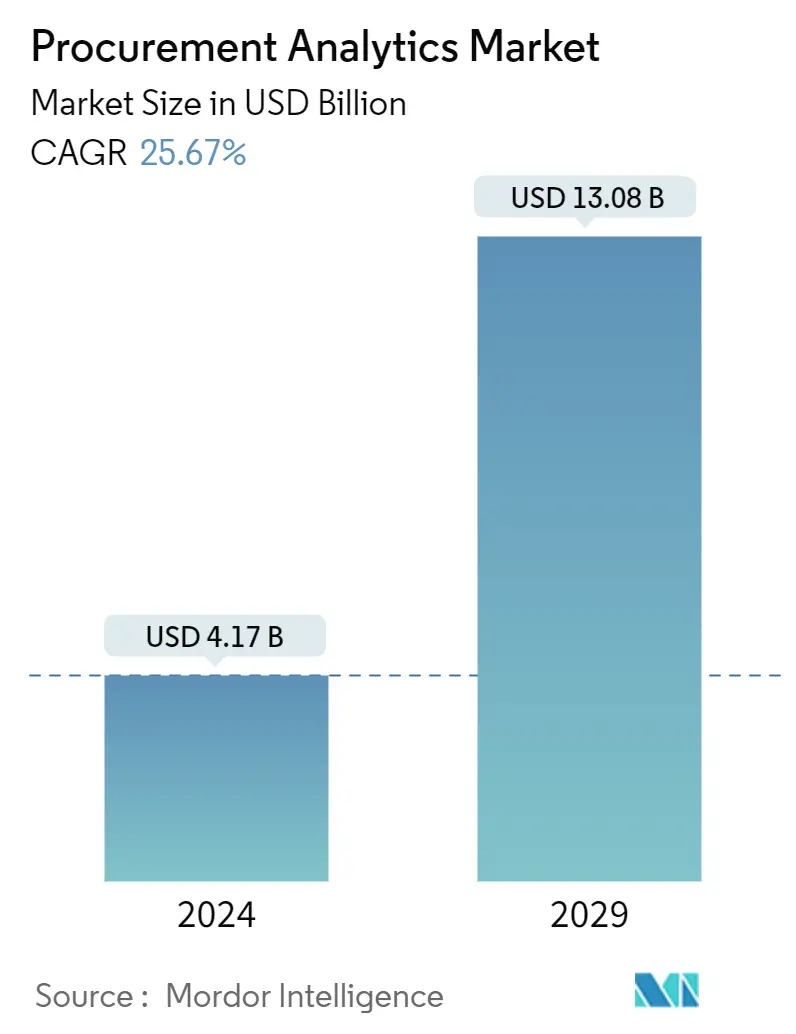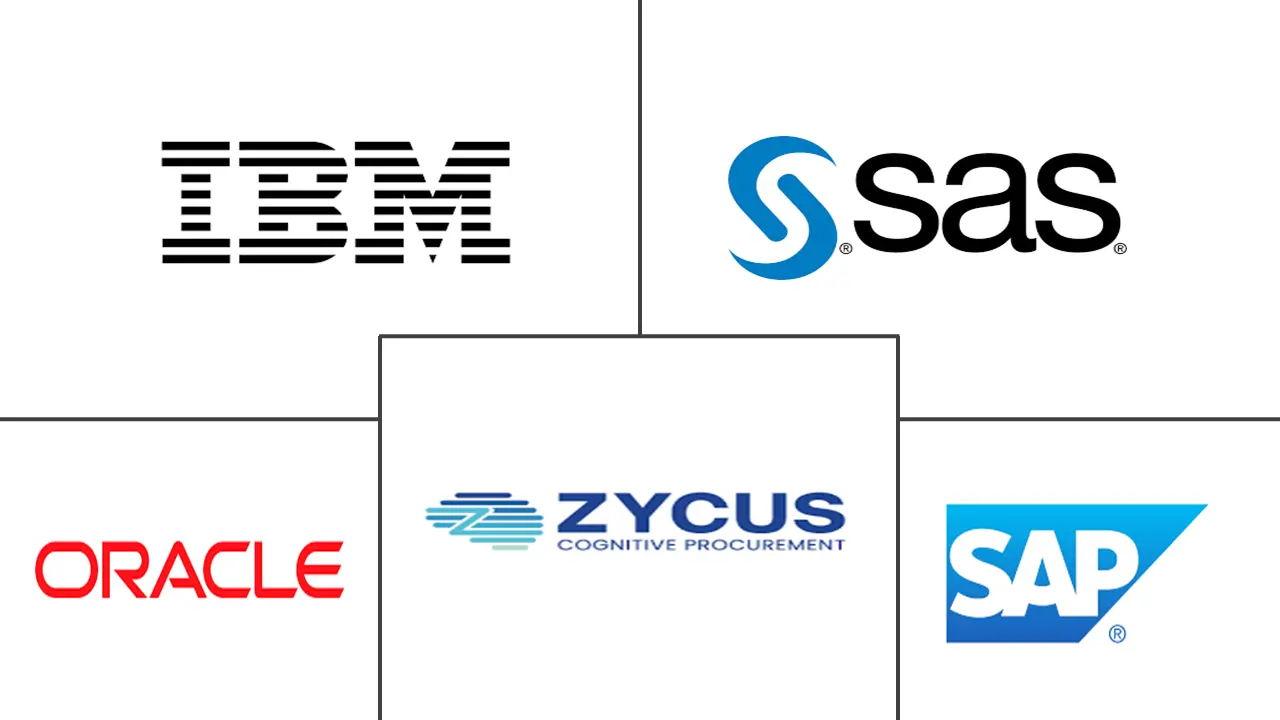Market Size of Procurement Analytics Industry

| Study Period | 2019-2029 |
| Market Size (2024) | USD 4.17 Billion |
| Market Size (2029) | USD 13.08 Billion |
| CAGR (2024 - 2029) | 25.67 % |
| Fastest Growing Market | Asia Pacific |
| Largest Market | North America |
| Market Concentration | Low |
Major Players
*Disclaimer: Major Players sorted in no particular order |
Procurement Analytics Market Analysis
The Procurement Analytics Market size is estimated at USD 4.17 billion in 2024, and is expected to reach USD 13.08 billion by 2029, growing at a CAGR of 25.67% during the forecast period (2024-2029).
To create a set of valuable insights that will help drive value and enhance operations, procurement analytics involves drawing on the vast pool of procurement data.
- The primary drivers of the market's expansion are the organizations' growing emphasis on improving their operational efficiencies in their procurement channels and their impending need to manage contracts and compliance policies.
- The advantages of spend analytics are also expanding, including the ability to get deeper insights through data visualization, enable the implementation of processes that save costs, make it simple to access enormous files, and provide data that is updated and located in real time. Improved use and consumption increase the system's scalability and lower the organization's investment.
- Furthermore, throughout the projection period, the market for procurement software is projected to have significant development potential due to the software's integration with artificial intelligence (AI). Technological developments will likely hasten market participants' revenue growth. On the contrary, more skilled personnel is needed to ensure market growth.
- Additionally, as business complexity related to data has grown, making decisions has become more complex. Small and medium-sized businesses need more resources to optimize the data around them, which could impede market expansion.
- The COVID-19 outbreak significantly impacted the development of the procurement analytics market. The rising popularity of smartphones, the increasing uptake of connected devices, and the booming e-commerce industry presented the market with promising opportunities for growth.
Procurement Analytics Industry Segmentation
Procurement analytics uses quantitative methods to derive actionable insights and results from the given data. This process helps organizations to improve their decision-making and gain a competitive advantage. Moreover, it ensures the correct usage of data for business management.
The Procurement Analytics Market is segmented by type (software, services), deployment type (on-premise, cloud), application (supply chain analytics, risk analytics, spend analytics, demand forecasting, contract management), end-user (manufacturing, supply chain & logistic, retail, and e-commerce, BFSI, IT & telecommunication), and geography (North America, Europe, Asia Pacific, Rest of the World). The report offers market forecasts and size in value (USD) for all the above segments.
| By Type | |
| Software | |
| Services |
| By Deployment Type | |
| On-Premise | |
| Cloud |
| By Application | |
| Supply Chain Analytics | |
| Risk Analytics | |
| Spend Analytics | |
| Demand Forecasting | |
| Contract Management |
| By End-User | |
| Manufacturing | |
| Transportation & Logistic | |
| Retail and E-commerce | |
| BFSI | |
| IT & Telecommunication | |
| Other End-Users (Education, Healthcare) |
| By Geography | |
| North America | |
| Europe | |
| Asia-Pacific | |
| Rest of the World |
Procurement Analytics Market Size Summary
The procurement analytics market is poised for substantial growth, driven by organizations' increasing focus on enhancing operational efficiencies and managing contracts and compliance policies. The integration of artificial intelligence with procurement software is expected to further propel market expansion, offering deeper insights through data visualization and real-time data access. Despite the promising growth trajectory, challenges such as the need for skilled personnel and the complexity of data-driven decision-making in small and medium-sized enterprises may hinder market progress. The COVID-19 pandemic has also played a significant role in shaping the market, with the rise of smartphones, connected devices, and the e-commerce boom presenting new opportunities for procurement analytics adoption.
North America currently dominates the global procurement analytics market, supported by a strong industrial base, government innovation programs, and high purchasing power. The region's growth is further bolstered by increased spending on risk management and supply chain analytics. Major players in the market are actively engaging in product innovations, partnerships, and acquisitions to strengthen their market presence. Notable developments include Zycus Inc's implementation of AI-enabled solutions for DeAcero and collaborations between SAS Institute Inc and Regenerative Medicine Development Organization to drive economic development through innovative technologies. These strategic moves highlight the competitive nature of the market and the ongoing efforts to leverage advanced analytics for improved procurement processes.
Procurement Analytics Market Size - Table of Contents
-
1. MARKET INSIGHTS
-
1.1 Market Overview
-
1.2 Industry Attractiveness - Porter's Five Forces Analysis
-
1.2.1 Bargaining Power of Suppliers
-
1.2.2 Bargaining Power of Consumers
-
1.2.3 Threat of New Entrants
-
1.2.4 Threat of Substitute Products
-
1.2.5 Intensity of Competitive Rivalry
-
-
1.3 Assessment of the Impact of COVID-19
-
-
2. MARKET SEGMENTATION
-
2.1 By Type
-
2.1.1 Software
-
2.1.2 Services
-
-
2.2 By Deployment Type
-
2.2.1 On-Premise
-
2.2.2 Cloud
-
-
2.3 By Application
-
2.3.1 Supply Chain Analytics
-
2.3.2 Risk Analytics
-
2.3.3 Spend Analytics
-
2.3.4 Demand Forecasting
-
2.3.5 Contract Management
-
-
2.4 By End-User
-
2.4.1 Manufacturing
-
2.4.2 Transportation & Logistic
-
2.4.3 Retail and E-commerce
-
2.4.4 BFSI
-
2.4.5 IT & Telecommunication
-
2.4.6 Other End-Users (Education, Healthcare)
-
-
2.5 By Geography
-
2.5.1 North America
-
2.5.2 Europe
-
2.5.3 Asia-Pacific
-
2.5.4 Rest of the World
-
-
Procurement Analytics Market Size FAQs
How big is the Procurement Analytics Market?
The Procurement Analytics Market size is expected to reach USD 4.17 billion in 2024 and grow at a CAGR of 25.67% to reach USD 13.08 billion by 2029.
What is the current Procurement Analytics Market size?
In 2024, the Procurement Analytics Market size is expected to reach USD 4.17 billion.

